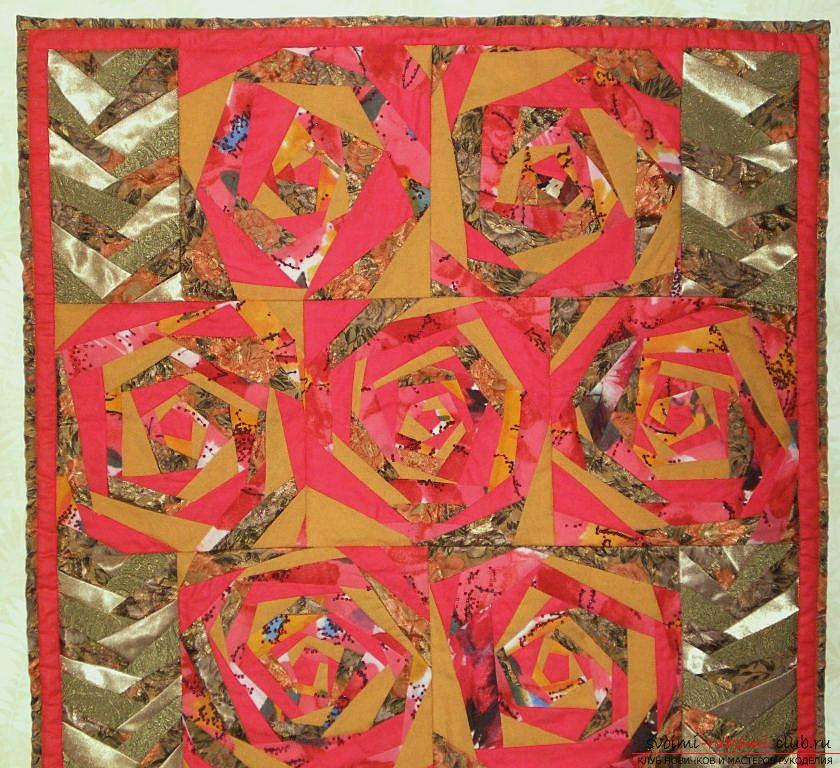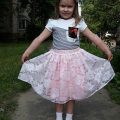
Decorative and applied art, the technique of patchwork sewing is simple and accessible to everyone
Decorative and applied arts, technologypatchwork sewing is very ancient, which has a long history. For someone it will seem very complicated, but in fact everything is simple. In order to learn how to work in it and create beautiful canvases, clothes, household items and accessories, you simply need to familiarize yourself with the basic rules for selecting shreds, combining them into one and different ways of this arts and crafts. How and when patchwork or patchwork appeared. Given the fragility that is characteristic of almost all tissues, it is unlikely that one will ever be able to establish the exact time of the appearance of the sewing technique from shreds. The first mention of products made in this way was in some historical sources of the 11th century. It is believed that the birthplace of the patchwork is England, although it is argued that this can not be anybody. It is possible that it was applied simultaneously in several corners of our planet. With her help, the craftsmen of Europe and America, Russia and Australia sewed clothes and household items. The main reason for their work was poverty. That is why they had to do something new and necessary from old unnecessary things, in particular things for themselves and children, bright blankets and beautiful bedspreads, pillows and children's toys. That is why splashes of development and popularity of sewing from shreds are connected with crisis life situations. In the people this kind of sewing has the original name "patchwork mosaic", as these two techniques, though different, but at the same time, are related. Perhaps the appearance of geometric (regular shape) drawings in canvases from pieces of fabric is a kind of imitation of ancient art (the creation of mosaic compositions). In the modern world, the technique of quilting is nothing more than a kind of decorative and applied art. The needlewomen from all countries unite in clubs and clubs, arrange exhibition events, festivals and thematic seminars, share experiences and demonstrate works of their creativity. In many of the museums in different parts of the world you can find copies of such shoe items, both past years, and creations more modern. Tools and materials needed to work in the technique of sewing from color patches For the manufacture of materials will be needed:
- tissue pieces that can be of different texture and color and are selected so that they are harmoniously combined;
- thread;
- materials for decoration: lace, fringe remnants, braid, beads, ribbons, rivets, buttons and so on.
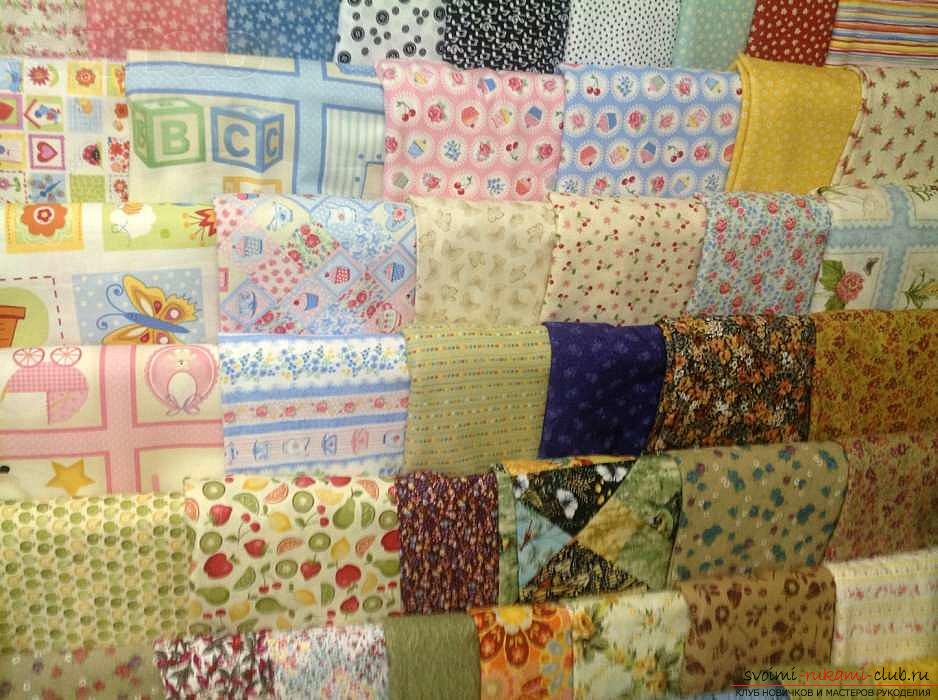 Equally important are the tools used:
Equally important are the tools used:
- Needles for handwork;
- sewing machine (better with the function of "zigzag line");
- Iron with a humidifier to smooth the seams on the created product;
- rulers of different lengths, triangle rectangular, compasses and patterns;
- sheets of paper in a cage to make sketches and schemes of future drawings;
- scissors very sharp or disk cutters with a special mat. It is on it that the blanks are cut from the fabric;
- steamer;
- Pins, ideally thin, in order to fix individual elements or layers of the future product.
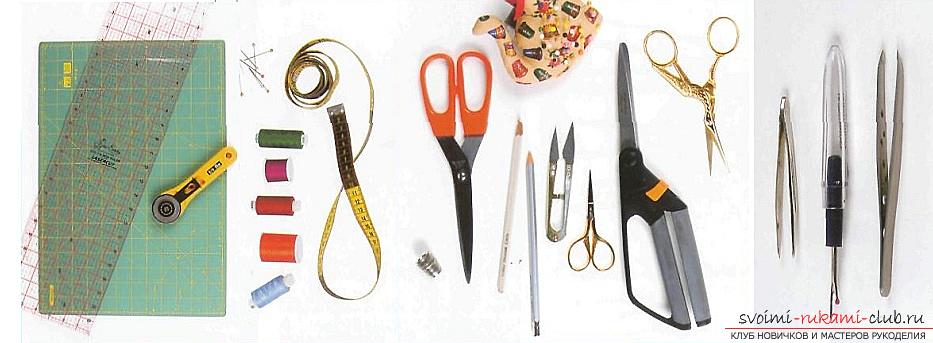 How to choose the right color scheme for tissueshreds To make the product really refined, beautiful and fit well into the interior, if we are talking about the subjects of this assignment, you should think carefully of the color solution. Provided that the part will be in a new house or room, you can take any color gamut, combine and create a masterpiece from any pieces of matter.
How to choose the right color scheme for tissueshreds To make the product really refined, beautiful and fit well into the interior, if we are talking about the subjects of this assignment, you should think carefully of the color solution. Provided that the part will be in a new house or room, you can take any color gamut, combine and create a masterpiece from any pieces of matter. 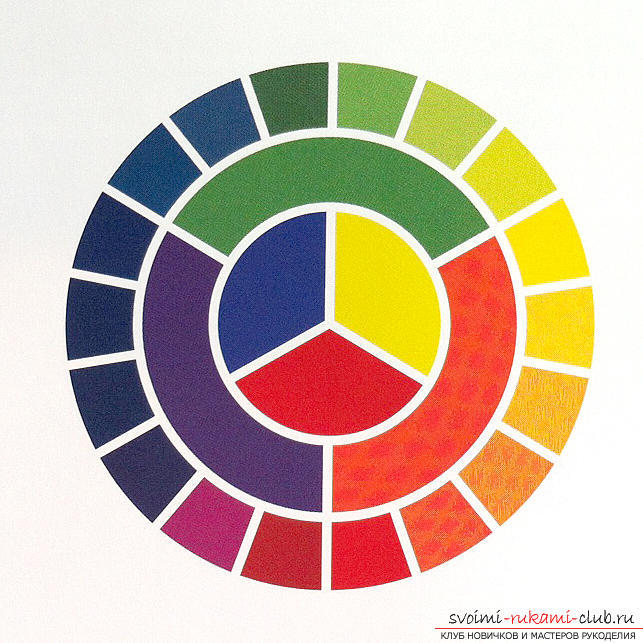 If you are unsure of whether thissolution of the product to you or your loved ones, you can use shreds that have classic colors or colors. Types of sewing techniques from shreds of fabric There are several types of this technique that are used in making panels, blankets, bedspreads, pillows, paintings, as well as clothing items.
If you are unsure of whether thissolution of the product to you or your loved ones, you can use shreds that have classic colors or colors. Types of sewing techniques from shreds of fabric There are several types of this technique that are used in making panels, blankets, bedspreads, pillows, paintings, as well as clothing items.
- Sewing of fabric strips - drawings "pineapple", "well", "chevron".
- Sewing of identical squares.
- Sewing of isosceles triangles ("mill", "Russian square", "card focus" and others).
- Free sewing technique from pieces of textiles ("crazy quilt", "rose").
Let's talk briefly about each of them. Sewing of strips is a technique that has been used for a long time and is the most common.  Strips of fabric are first made, thensew together. When cutting them, separate blocks are obtained. Subsequently, the blocks are sewn into a holistic web forming the finished product. For this technique, even old unnecessary things will do. It is best to start sewing a product from the central part, placing a square or a block of another geometric shape there, and then sewing individual fragments. The allowance is a half-centimeter of fabric. We will consider sewing from strips on an example of a pattern "Log hut", which else name "well", "frame" or "the American square". The assembly consists in sewing the strips of cloth to a square placed in the center. Traditionally, the square has a red color, and the stripes are used in light and dark shades. Light tones are lighted corners, dark tones symbolize shadow corners. The process is simple. The diagram shows in more detail how to properly sew the strips.
Strips of fabric are first made, thensew together. When cutting them, separate blocks are obtained. Subsequently, the blocks are sewn into a holistic web forming the finished product. For this technique, even old unnecessary things will do. It is best to start sewing a product from the central part, placing a square or a block of another geometric shape there, and then sewing individual fragments. The allowance is a half-centimeter of fabric. We will consider sewing from strips on an example of a pattern "Log hut", which else name "well", "frame" or "the American square". The assembly consists in sewing the strips of cloth to a square placed in the center. Traditionally, the square has a red color, and the stripes are used in light and dark shades. Light tones are lighted corners, dark tones symbolize shadow corners. The process is simple. The diagram shows in more detail how to properly sew the strips. 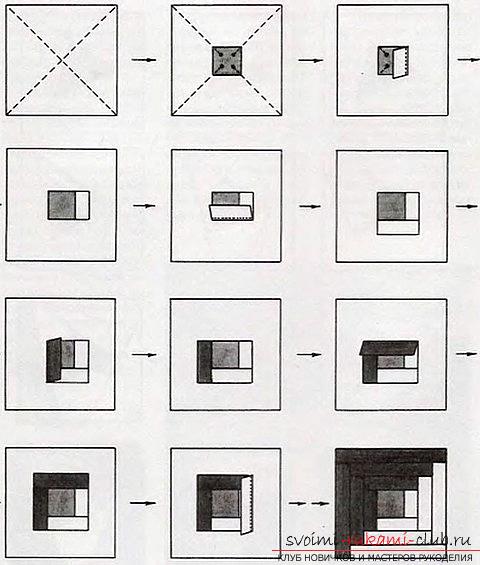 Sewing of squares is quite an old technique of this kind of sewing.
Sewing of squares is quite an old technique of this kind of sewing. 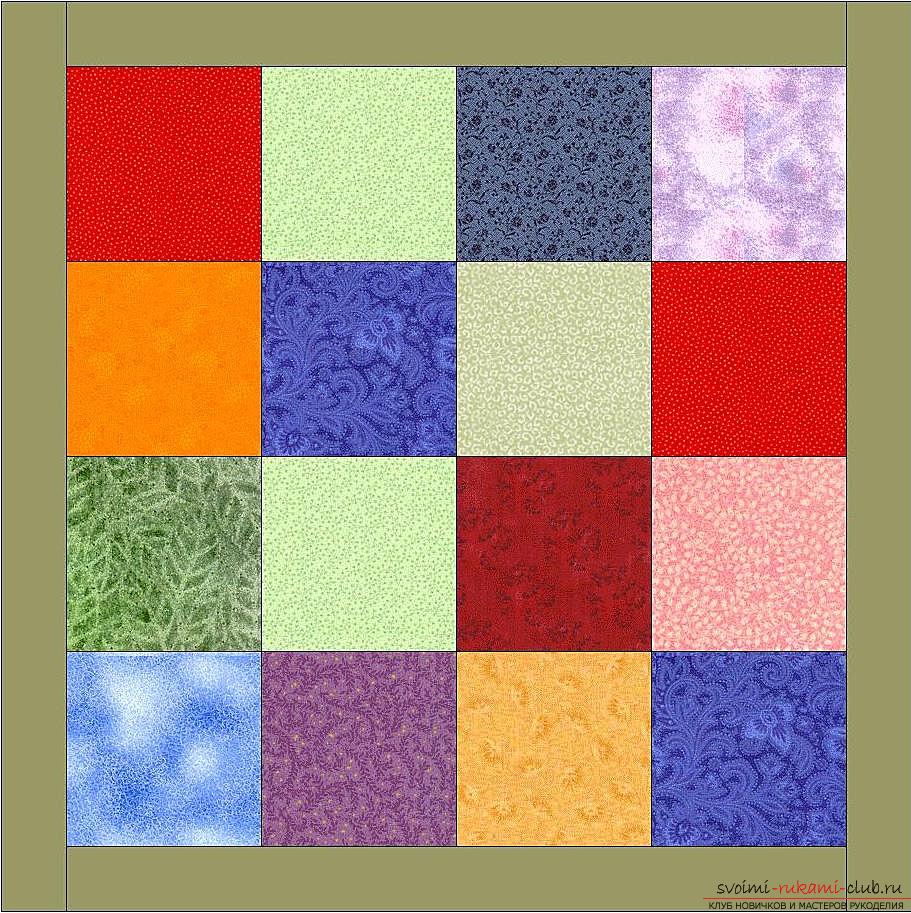 It is very demanded and simple. In the old days it was widely used in rural areas, where the fabric was worth its weight in gold and was practically a waste-free raw material for work. Its essence consists of cutting out squares of the same size, which are calculated from a previously drawn out sketch. Then the squares are stitched first into strips, and the finished strips are stitched together. If the product will have a rectangular shape, it will be more convenient to sew it on its short side. The diagram below shows how to properly sew individual squares, and then stripes from squares.
It is very demanded and simple. In the old days it was widely used in rural areas, where the fabric was worth its weight in gold and was practically a waste-free raw material for work. Its essence consists of cutting out squares of the same size, which are calculated from a previously drawn out sketch. Then the squares are stitched first into strips, and the finished strips are stitched together. If the product will have a rectangular shape, it will be more convenient to sew it on its short side. The diagram below shows how to properly sew individual squares, and then stripes from squares. 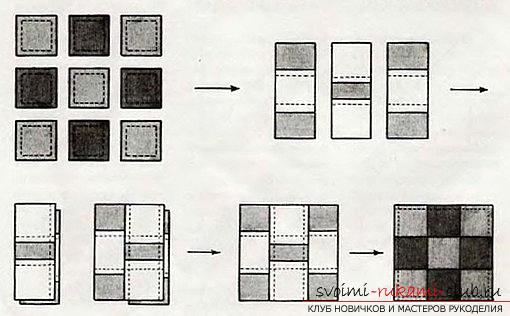 Sewing of triangles is a very old technique. According to some sources, it is believed that her invention is rightfully owned by Russian needlewomen. Blanket made in this technique, at times was the only decoration in the hut of the villagers.
Sewing of triangles is a very old technique. According to some sources, it is believed that her invention is rightfully owned by Russian needlewomen. Blanket made in this technique, at times was the only decoration in the hut of the villagers.  From the fabric are cut multicolored identicalisosceles triangles. This can be done according to a pre-prepared template, which will greatly facilitate the process of cutting. Then the triangles are joined in squares, and the squares are already in the canvas of the required shape. The patterns resulting from the work have a geometric shape. A vivid example of this technique is the "Mill" pattern. It consists of two colors and for its creation you need eight triangles - four of them have one color, four more - another. Triangles are sewn into a square as shown in the diagram, and then from the squares sew the product.
From the fabric are cut multicolored identicalisosceles triangles. This can be done according to a pre-prepared template, which will greatly facilitate the process of cutting. Then the triangles are joined in squares, and the squares are already in the canvas of the required shape. The patterns resulting from the work have a geometric shape. A vivid example of this technique is the "Mill" pattern. It consists of two colors and for its creation you need eight triangles - four of them have one color, four more - another. Triangles are sewn into a square as shown in the diagram, and then from the squares sew the product. 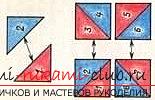 Free technique of patchwork sewing or"Crazy quilt." Perhaps, the most interesting technique of this kind of needlework. There are no rules or the order of sewing individual shreds, there is no provision for creating a sketch. It can use even very small pieces of material, buttons, laces, ribbons and braids and so on. The picture, which will loom in the end, depends only on the imagination and creativity of the thinking of the needlewoman herself. In the end, you can get an amazing colorful drawing that will make any product exclusive.
Free technique of patchwork sewing or"Crazy quilt." Perhaps, the most interesting technique of this kind of needlework. There are no rules or the order of sewing individual shreds, there is no provision for creating a sketch. It can use even very small pieces of material, buttons, laces, ribbons and braids and so on. The picture, which will loom in the end, depends only on the imagination and creativity of the thinking of the needlewoman herself. In the end, you can get an amazing colorful drawing that will make any product exclusive. 